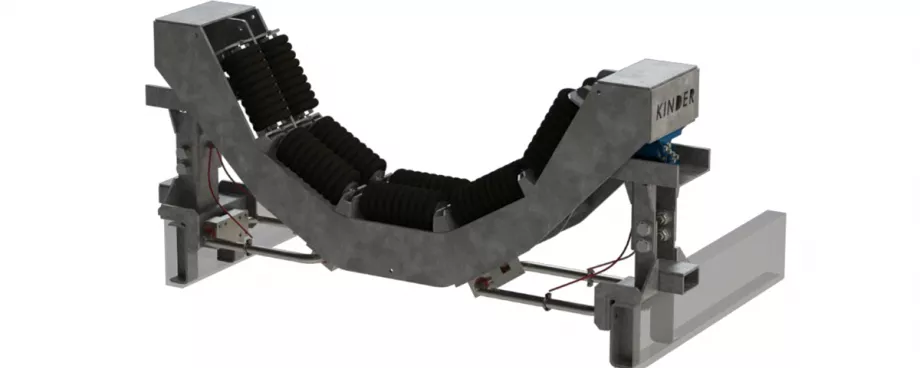To get the ESL 50 series anti-vibration mount in its working range (Fig. 29, thick section blue line), an amount of sprung weight (Eq. 1) is required to get within its optimal range, for impact to then be able to deflect the mount further. The minimum working range should also consider the flow rate force from the product stream (Eq. 2), for large lump impact to then use the remaining range of the mount. If the minimum weight requirement is not met, the system risks being too stiff when impacted. Given the standard ESL 50 utilised 6 mm steel profile plates and larger sizes 8 mm, we wanted to at least meet the working range of the ESL 50-1.6.
The sprung mass (ms) consists of the following:
| Symbol | Description | Quantity |
|---|---|---|
| mr | Mass of roller | 26.2 kg |
| mf | Mass of frame (sprung part, 16 mm transom plates) | 365 kg |
| x | Idler spacing (as per current install) | 0.6 m |
| mb | Mass of belt | 90 kg/m |
| mp | 382 kg/m |
The static mass under normal conditions in kilograms is calculated as:
| (1) |
Also to be considered is the stream flow rate force (Fflow) under normal conditions:
| Symbol | Description | Quantity |
|---|---|---|
| q | 1528 kg/s | |
| v |
a = 9.81 m/s2 |
10.58 m/s |
Consistent with the simplified version of Eq. 10.2 as shown by Swinderman et.al. [1], the stream flow rat force in Newton is calculated as:
| (2) |
Assuming the stream flow rate force occurs over a “belt width” (1800 mm) worth of frames at 600 mm spacings; therefore 4 frames, the quantity of mounts over which this force occurs is 8 (2 mounts per frame). This stream flow rate force can then be divided by 8 and the static mass can be divided by 2 as this force occurs over 2 mounts (one frame), thus given the minimum force applied to anti-vibration mount in normal conditions (in Newton):
| (3) |
The minimum force requirement came in at 6485 N per anti-vibration mount. This is outside of the minimum range of the ESL 50-2, installation of which would likely make the system too stiff. Selection of the ESL 50 met the minimum force criteria; however, the ESL 50-1.6 is more suitable due to a greater range and thicker 8 mm steel profile plates.
Whilst the use of 16 mm plate for the transom may be excessive, given the impact force will now be reduced due to the dynamic feature, it is necessary to achieve a greater static mass, therefore allowing the idler to utilise an anti-vibration mount with a greater working range. It also put the clients mind at ease, given the original cradle utilised 16 mm plate for the transom.























